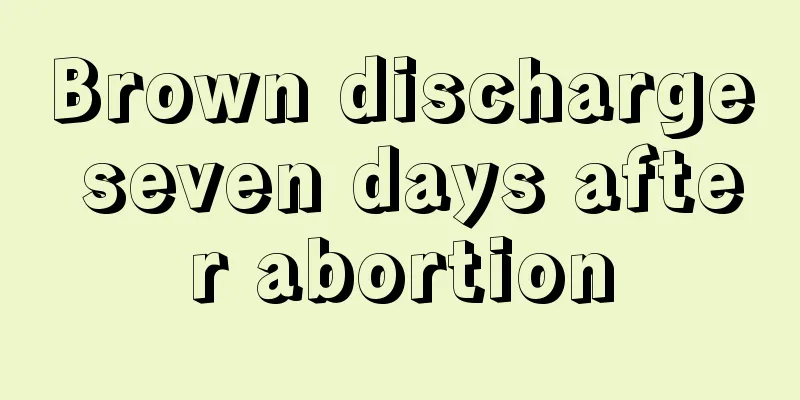How long does the ovulation cooling last?

|
Generally speaking, from the physiological perspective of female pregnancy, the female body temperature will drop when the fertilized egg implants. This is also a major symptom of implantation cooling. However, some women find that they do not experience this when monitoring their basal body temperature. This often means that they are not pregnant. If ovulation cooling occurs, it will greatly increase the chance of conception. Let us understand how long ovulation cooling lasts. 1. How many days does it take for the egg to implant after intercourse? How many days after intercourse does it take for implantation? After intercourse, the fertilized egg will implant in the endometrium after 6-8 days. Implantation marks the beginning of pregnancy. At this time, most pregnant women do not have any conscious symptoms of pregnancy, but some will have symptoms similar to a cold. If menstruation is delayed, you can go to the hospital in time for a urine pregnancy test to confirm whether you are pregnant. Generally speaking, the gestational sac can be seen under B-ultrasound 50 days after pregnancy. 2. Fertilized egg implantation temperature How does the body temperature change when the fertilized egg implants? First, we record the basal body temperature measured every day on a temperature record sheet and connect them into a curve. By observing the temperature changes on the temperature record, it can be seen that the body temperature will drop after the fertilized egg implants. A woman's menstrual cycle is generally 21-35 days (about 28 days on average), which is divided by the day of ovulation. The day after ovulation, the corpus luteum is formed in the ovary and the secretion of progesterone will cause the body temperature to rise by 0.3-0.6 degrees Celsius, causing the body temperature to fluctuate between high and low phases. When the temperature transitions from low temperature to high temperature, an extremely low temperature will occur. The day when the extremely low temperature occurs is the ovulation day. The high temperature period lasts about 12-16 days (14 days on average). When you find that the body temperature suddenly drops one day during the high temperature period (about the 6th to 10th day after ovulation), and then rises significantly on the second day, this sudden low temperature is the implantation cooling. 3. How much does the egg temperature drop after implantation? The temperature of the fertilized egg generally drops after implantation. How much does the temperature drop during implantation? The temperature drop during implantation is generally around 0.5℃. The situation is different for women with different physiques, and the degree of cooling during implantation varies. To understand how much the temperature drops during implantation, women need to measure their basal body temperature every day. Basal body temperature should be measured in the morning when you wake up, and make sure you sleep for more than 6 hours the night before. It is not accurate enough to rely on basal body temperature to determine whether the fertilized egg has implanted. If your period is delayed for more than 7 days, you can use an early pregnancy test strip or go to the hospital for an ultrasound examination to more accurately determine whether you are pregnant. 4. How many days does the cooling of the egg implantation last? How many days does the cooling after implantation last? Generally speaking, the cooling after implantation lasts for 1 day, and the body temperature will resume rising the next day. Implantation cooling is a reference symptom for judging the successful implantation of the fertilized egg. A woman's body temperature will drop during ovulation, but after successful ovulation, her body temperature will continue to rise, lasting for about 12 days. Implantation usually occurs between the 8th and 10th days after ovulation. If the body temperature drops suddenly but rises significantly the next day, then this sudden drop in temperature is cooling for implantation. By measuring the basal body temperature, you can preliminarily determine whether you are pregnant. If a woman's high temperature period exceeds 16 days and enters the 18th day, then the possibility of pregnancy is greater. However, it is recommended to go to the hospital for an ultrasound examination to determine whether conception is successful. |
<<: What is the principle of breast lactation?
>>: Is the ovulation date fixed every month?
Recommend
Does leucorrhea with odor affect the baby?
There are many reasons why vaginal discharge has ...
Why are my hands swollen at 34 weeks of pregnancy?
Everyone knows that pregnancy is very hard, espec...
How long does it take to get menstruation after having an abortion?
Many women choose to have an abortion after becom...
How to choose a belly band, the best one is the one that suits you best
After ten months of pregnancy, the originally enl...
Can I have artificial insemination after having a vasectomy?
Female sterilization is the process of tubal liga...
Dietary considerations for a big belly during pregnancy
Many mothers who have just become pregnant will b...
How to lose belly fat after giving birth
For most women, their biggest concern after givin...
Is it good to sprinkle wood ash on garlic? When is the best time to sprinkle wood ash on garlic?
Someone asked if you can sprinkle wood ash on gar...
What is the best oil to use for boiled fish? What is the detailed method of boiled fish?
Modern people like to eat boiled fish very much. ...
What are the normal reactions when using erosive suppositories?
Gynecological diseases have always been a problem...
Will breasts still develop at 18?
In fact, it takes a long time for women's bre...
Millennial Media: Android ranked first in global mobile device advertising market share in August 2011
The latest report released by mobile advertising ...
What should I do if I have trichomoniasis?
In daily life, many women, like men, struggle har...
Is it okay to take birth control pills one month after an abortion?
You cannot have sex within one month after an abo...









